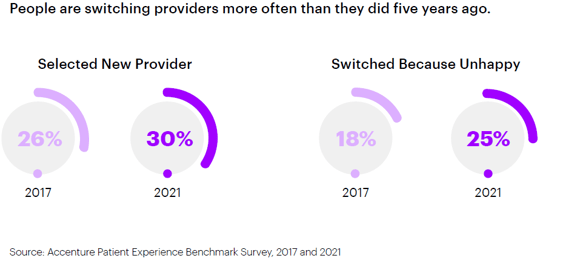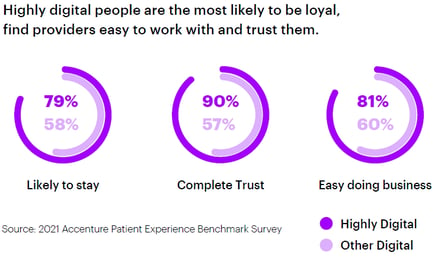It’s no surprise that patient experience expectations are evolving and those expectations are permanently changing the healthcare landscape. Nearly one-third (30%) of patients selected a new provider in 2021 with younger generations being almost 6 times more likely to switch providers than older adults. And almost 80% of patients who switched providers cited ease of navigation, including experiences with administrative staff and a lack of digital solutions as their reason for leaving.1

Healthcare organizations want to know what it is that patients really value and how they can ensure they are investing in the right areas to keep pace with an evolving, increasingly person-centric healthcare model.
When I came across the Accenture report on patient loyalty, I was happy to find such a comprehensive summary that clearly articulates the fundamentals of patient loyalty, which are reshaping healthcare models and are the keys to informing business decisions for both healthcare providers and healthcare technology companies.
This report surveyed almost 21,000 patients in the US to uncover the key drivers of patient loyalty and I wanted to share a quick summary of the main takeaways with the hope that you can walk away with even one idea to inform your practice’s business decisions going forward. The report homes in on 4 key drivers of patient engagement and loyalty:
1) Access
2) Ease of doing business
3) Digital engagement
4) Trust
Access
At the top of the list of factors that patients consider when selecting providers, 71% of patients cited access. Access refers to things like location, appointment availability, hours of service, customer service, and the ability for patients to connect with their provider through their preferred pathways including digital scheduling, telehealth, and virtual care offerings.
Ease of doing business
The report found loyalty is very closely tied to how easy patients find it to do business with their providers. Ease of doing business refers to the interactions and experiences of the patient throughout their healthcare journey.
Not surprisingly, the report found that the impact of these rankings on patient loyalty is substantial, with patients being 9 times more likely to stay with a provider who they find very easy to work with versus patients who find a provider difficult to work with. As well, patients were still 3 times more likely to stay with a provider even if they are only somewhat easy to work with as compared to a provider who is difficult to work with.
So, what specifically makes a provider easy to do business with? Interestingly, the research found that a patient’s level of digital engagement strongly correlates with the ease of doing business, with 81% of digitally engaged patients finding providers easy to deal with.
Digital engagement
The survey found that nearly 80% of patients who considered themselves highly digital are those people who are likely to stay with their providers.
Our key takeaway from the digital engagement category is the strong connection between digital engagement and trust. Notably, 90% of patients who were highly digitally engaged indicated that they have complete trust in their provider, which, perhaps unsurprisingly, is the strongest predictor of loyalty.

Trust: The common thread
An overwhelming 84% of patients who trust their provider are likely to stay.
So, with trust being the biggest predictor of loyalty, the question is, how can providers build trust in a way that is genuine, but scalable? We know that when we can interact with a person one-on-one, we build trust through repeated, meaningful interactions where we show kindness, patience, and active listening. We also know that budgets only allow for so many extra hands to offer person-to-person interactions, and that we now have a younger population who feels more trusting of their providers when they offer digital engagement options.
The key is finding a balance between those in-person and digital interactions to build that solid foundation of trust and that’s where digital patient engagement solutions come in.
Building scalable connections through a patient engagement application
To drive a balance between technological and human interaction, a patient engagement application should not only allow your practice to regularly engage with patients in the ways that are most meaningful and convenient to them, but also offer tools that drive clinical efficiency so that your practice can direct more energy into those invaluable personal experiences that are so important for establishing trust. According to the Accenture report, the experiences that have the highest impact on trust are when:
- Patients feel informed with a clear understanding of their diagnosis and treatment.
- Patients are clear about what their treatment requires.
- Patients perceive that their care team works well together and can answer questions.
So, when you are looking for a digital patient engagement solution, it is important that you look for something that not only addresses these high-value touchpoints, but allows you to exceed these expectations so you can proactively address the needs of the next generation of patients. Keeping the ideas of access, ease of doing business, digital engagement, and trust in mind, here are a few key features to look for:
- Communication tools such as video and chat that offer convenience, flexibility, and efficiency for patients and staff alike so that everyone finds it easy to engage.
- Tools that allow providers to automate touch points with the patient throughout their entire healthcare journey.
- The ability to deliver patient education content about diagnosis and treatments that are consistent with your practice and specific to the patient’s needs.
- Access to information for both patients and their families so that communication remains consistent for everyone throughout an episode of care.
- Data collection capabilities that allow you to measure and evaluate the patient experience so that you can improve the patient experience over time.
Digital is not a destination
One quote from the report that really resonated with me is, “Digital is not a destination. It is the means to the end of humanizing health experiences.” A patient engagement platform is not designed to replace human interaction; it is there to provide access and information and to free up clinical resources so that you and your staff have more time for meaningful, person-centric interactions that help establish trust and drive loyalty.
About the author: Mary Pat Hinton

Mary Pat is the CEO and co-founder of Emmetros, the creators of SparxConnect. In 2014, she left her corporate leadership role to pursue her heart-work by launching Emmetros. Driven by a commitment to honor her late grandmother, Mary Pat set out to create technology that prioritizes the independence and dignity of the person receiving care.
References

